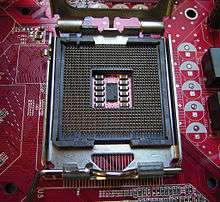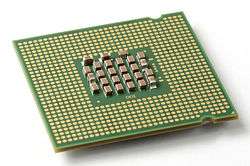Land grid array

The land grid array (LGA) is a type of surface-mount packaging for integrated circuits (ICs) that is notable for having the pins on the socket (when a socket is used) rather than the integrated circuit.[1] An LGA can be electrically connected to a printed circuit board (PCB) either by the use of a socket or by soldering directly to the board.
Description
The land grid array is a packaging technology with a rectangular grid of contacts on the underside of a package. The contacts are to be connected to a grid of contacts on the PCB. Not all rows and columns of the grid need to be used. The contacts can either be made by using an LGA socket, or by using solder paste.[2]
LGA packaging is related to ball grid array (BGA) and pin grid array (PGA) packaging. Unlike pin grid arrays, land grid array packages are designed to fit either in a socket, or be soldered down using surface mount technology. PGA packages cannot be soldered down using surface mount technology. In contrast with a BGA, land grid array packages in non socketed configurations have no balls, and use flat contacts which are soldered directly to the PCB. BGA packages, however have balls as their contacts in between the IC and the PCBs. The balls are normally attached to the underside of the IC.
Use in microprocessors
LGA is used as a physical interface for microprocessors of the Intel Pentium 4 (Prescott), Intel Xeon, Intel Core 2, Intel Core (Bloomfield and Lynnfield) and AMD Opteron families. Unlike the pin grid array (PGA) interface found on most AMD and older Intel processors, there are no pins on the chip; in place of the pins are pads of bare gold-plated copper that touch protruding pins on the microprocessor's connector on the motherboard.
While LGA sockets have been in use as early as 1996 by the MIPS R10000 and HP PA-8000 processors, the interface did not gain widespread use until Intel introduced their LGA platform, starting with the 5x0 and 6x0 sequence Pentium 4 (Prescott) in 2004. All Pentium D and Core 2 desktop processors use LGA 775 socket. As of Q1 2006, Intel switched the Xeon server platform to LGA, starting with the 5000-series models. AMD introduced their server LGA platform starting with the 2000-series Opteron in Q2 2006. AMD offered the Athlon 64 FX series on socket 1207FX through ASUS's L1N64-SLI WS motherboards. It was the only desktop LGA solution offered by AMD.
The most common Intel desktop LGA socket is dubbed LGA 1150 (Socket H3), which is used with Intel's Haswell and Broadwell series Core i3, i5, and i7 families, as well as their lower-end Pentium and Celeron families. However, the Haswell-E Core i7 family uses the LGA 2011 (Socket R) socket. The LGA setup provides higher pin densities, allowing more power contacts and thus a more stable power supply to the chip. LGA packaging also has a tertiary benefit of placing pins onto the motherboard; if a pin breaks, the motherboard is often cheaper to replace than the CPU chip (as compared to a PGA chip/socket setup).
The AMD server LGA socket is designated Socket G34 (LGA 1944). Like Intel, AMD decided to use LGA sockets for their higher pin densities, as a 1944-pin PGA would simply be too large for most motherboards.
AMD
- Socket F (LGA 1207)
- Socket C32 (LGA 1207) (replaces Socket F)
- Socket G34 (LGA 1944)
- SP3 LGA
Intel
- LGA 775 (Socket T)
- LGA 771 (Socket J)
- LGA 772 (Socket J)
- LGA 1366 (Socket B)
- LGA 1356 (Socket B2)
- LGA 1156 (Socket H)
- LGA 1155 (Socket H2)
- LGA 1150 (Socket H3)
- LGA 2011 (Socket R)
- LGA 1151 (Socket H4)
See also
- Chip carrier
- Dual in-line package (DIP)
- Pin grid array (PGA)
- Ball grid array (BGA)
References
- ↑ "Definition of:LGA". PC Magazine. Retrieved October 1, 2015.
- ↑ "Land Grid Array (LGA) Socket and Package Technology" (PDF). Intel. Retrieved October 1, 2015.
